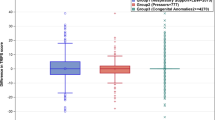Abstract
Objective:
To develop a strategy to assess the quality of neonatal transport based on change in neonatal condition during transport.
Study Design:
The Canadian Transport Risk Index of Physiologic Stability (TRIPS) score was optimized for a California (Ca) population using data collected on 21 279 acute neonatal transports, 2007 to 2009, using models predicting (2/3) and validating (1/3) mortality within 7 days of transport. Quality Change Point 10th percentile (QCP10), a benchmark of the greatest deterioration seen in 10% of the transports by top-performing teams, was established.
Result:
Compared with perinatal variables (0.79), the Ca-TRIPS had a validation receiver operator characteristic area for prediction of death of 0.88 in all infants and 0.86 in infants transported after day 7. The risk of death increased 2.4-fold in infants whose deterioration exceeded the QCP10.
Conclusion:
We present a practical, benchmarked, risk-adjusted, estimate of the quality of neonatal transport.
This is a preview of subscription content, access via your institution
Access options
Subscribe to this journal
Receive 12 print issues and online access
$259.00 per year
only $21.58 per issue
Buy this article
- Purchase on Springer Link
- Instant access to full article PDF
Prices may be subject to local taxes which are calculated during checkout


Similar content being viewed by others
References
Ferrara A, Atakent Y . Neonatal stabilization score. A quantitative method of auditing medical care in transported newborns weighing less than 1000 g at birth. Med Care 1986; 24 (2): 179–187.
Orr RA, Venkataraman ST, Cinoman MI, Hogue BL, Singleton CA, McCloskey KA . Pretransport Pediatric Risk of Mortality (PRISM) score underestimates the requirement for intensive care or major interventions during interhospital transport. Crit Care Med 1994; 22 (1): 101–107.
Broughton SJ, Berry A, Jacobe S, Cheeseman P, Tarnow-Mordi WO, Greenough A et al. The mortality index for neonatal transportation score: a new mortality prediction model for retrieved neonates. Pediatrics 2004; 114 (4): e424–e428.
Lee SK, Zupancic JA, Pendray M, Thiessen P, Schmidt B, Whyte RZupancic JA et al. Transport risk index of physiologic stability: a practical system for assessing infant transport care. J Pediatr 2001; 139 (2): 220–226.
Broughton SJ, Berry A, Jacobe S, Cheeseman P, Tarnow-Mordi WO, Greenough A . An illness severity score and neonatal mortality in retrieved neonates. Eur J Pediatr 2004; 163 (7): 385–389.
Eliason SH, Whyte H, Dow K, Cronin CM, Lee S Canadian Neonatal Network. Variations in transport outcomes of outborn infants among Canadian Neonatal Intensive Care Units. Am J Perinatol 2013; 30: 377–382.
Hermansen MC, Hasan S, Hoppin J, Cunningham MD . A validation of a scoring system to evaluate the condition of transported very-low-birthweight neonates. Am J Perinatol 1988; 5 (1): 74–78.
Lee SK, Zupancic JA, Sale J, Pendray M, Whyte R, Brabyn D . Cost-effectiveness and choice of infant transport systems. Med Care 2002; 40 (8): 705–716.
Schreiner K, Reynolds JW, Benda G . A scoring system for evaluating the condition of transported neonates. Air Med J 1993; 1 (4): 89–92.
Ramnarayan P . Measuring the performance of an interhospital transport service. Arch Dis Child 2009; 94: 414–416.
Lorch SA, Silber JH, Even-Shoshan O, Millman A . Use of prolonged travel to improve pediatric risk-adjustment models. Health Serv Res 2009; 44 (2 Part 1): 519–541.
Mori R, Fujimura M, Shiraishi J, Evans B, Corkett M, Negishi H . Duration of inter-facility neonatal transport and neonatal mortality: systematic review and cohort study. Pediatr Int 2007; 49 (4): 452–458.
Leslie AJ, Stephenson TJ . Audit of neonatal intensive care transport—closing the loop. Acta Paediatr 1997; 86 (11): 1253–1256.
Meberg A, Hansen TW . Quality evaluation of neonatal transports. Tidsskr Nor Laegeforen 2005; 125 (18): 2474–2476.
Acknowledgements
CPeTS data: This work was supported by California Department of Health, Maternal Child and Adolescent Health Branch.
Author information
Authors and Affiliations
Corresponding author
Ethics declarations
Competing interests
The authors declare no conflict of interest.
Appendices
Appendix Table A1
Appendix Table A2
Appendix Table A3
Appendix Table A4
Rights and permissions
About this article
Cite this article
Gould, J., Danielsen, B., Bollman, L. et al. Estimating the quality of neonatal transport in California. J Perinatol 33, 964–970 (2013). https://doi.org/10.1038/jp.2013.57
Received:
Revised:
Accepted:
Published:
Issue Date:
DOI: https://doi.org/10.1038/jp.2013.57
Keywords
This article is cited by
-
Neonatal neurologic emergencies requiring access to paediatric emergency units: a retrospective observational study
Scientific Reports (2022)
-
Observational study on the efficiency of Neonatal Emergency Transport in reducing mortality and morbidity indexes in Sicily
Scientific Reports (2021)
-
Clinical deterioration during neonatal transport in California
Journal of Perinatology (2020)
-
Neonatal transport in California: findings from a qualitative investigation
Journal of Perinatology (2020)
-
Comparison of state risk-appropriate neonatal care policies with the 2012 AAP policy statement
Journal of Perinatology (2018)


